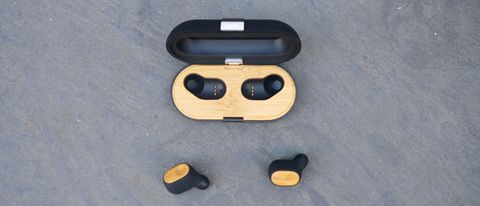TechRadar Verdict
If you’re a dedicated eco-warrior, these bamboo-clad buds could be a great way to go wireless; however, a bass-heavy soundstage means they don’t compete with audiophile true wireless earbuds like the Cambridge Audio Melomania 1.
Pros
- +
Eco-friendly design
- +
Comfortable fit
- +
Easy controls
Cons
- -
Overpowering bass
- -
Trebles lacking detail
Why you can trust TechRadar
As a society, we’re more eco-conscious than ever, with many of us making the effort to buy sustainably and recycle our household waste – but when it comes to tech, it’s easy to feel left in the dark about which products are environmentally friendly.
Enter the House of Marley Liberate Airs: true wireless earbuds that are made from sustainable materials, including bamboo, recyclable aluminum, recycled plastic bottles, and sawdust.
They certainly sound like they’re good for the environment, but are they good for your ears too?
Price and availability
The House of Marley Liberate Airs are available to buy for $149.99 / £129.99 / AU$249.95, making them slightly cheaper than the Apple AirPods.
However, they’re more expensive than the fantastic Cambridge Audio Melomania 1s and budget options like the Optoma NuForce BE Free6, which cost just $99 (£99, AU$130).
- When will we see the Apple AirPods 2?
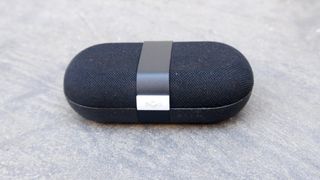
Design
These wireless earbuds are certainly striking, with a gorgeous bamboo finish and black rubberized accents.
The pill-shaped buds sport bamboo-clad outer housings, with a subtle groove carved into the back to make it easier to place them into your ear. They aren’t the smallest true wireless earbuds we’ve tested, but their sleek form and subtle mixed-media design means they look great nonetheless.
The use of bamboo isn’t just for aesthetic purposes; the House of Marley Liberate Airs are designed to be eco-friendly, using sustainable materials that are both stylish and do good for the planet.
According to House of Marley, they’re crafted from a mixture of "bamboo, recyclable aluminum, natural wood fibre composite made from sawdust" and the brand's signature fabric, which is composed of recycled plastic bottles.
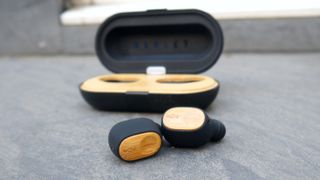
Those materials are also utilized within the all-black charging case, which features a snap-shut lid kitted out in House of Marley’s recycled fabric. A small aluminum clasp with the brand’s logo make it easier to open and shut, while a row of four small LEDS gives you an indication of the case’s remaining battery life.
On the back of the charging case you’ll find a micro-USB charging port, which is concealed by a rubber flap to keep the vital innards safe from the debris rattling around the bottom of your bag.
You get two additional eartip sizes included in the box, which means you should be able to find a snug fit; we found that the earbuds were most comfortable when using the smallest size, which also provided the best seal against our ear canals.
They feel secure enough to be used as running headphones; and, with an IPX4 water-resistance rating they’ll withstand a sweaty workout, but you won't be able to take them in the shower with you once you’ve finished training for the day.

Features and battery life
Like the Apple AirPods, the Liberate Airs are designed with a seamless pairing experience in mind; House of Marley says that once you've first paired them with your device, they'll automatically connect as soon as you open the charging case.
The outer housings of the earbuds feature touch controls, which allow you to control your music playback, calls, and summon your device's voice assistant, whether you use Google Assistant or Siri.
Tap twice to on the right earbud to play and pause your music, and tap three times on the same side to skip to the next track. Tapping three times on the left earbud will take you back to the previous track.
To answer a call you need to tap twice on the right earbud, and to reject a call, just tap twice on the left earbud.
Tapping twice on the left earbud when you don’t have a call in progress will summon your voice assistant.
It’s worth bearing in mind that these controls are transferred to one earbud if you decide to listen in Mono Mode, which is when the full stereo mix comes out of only one earbud – a useful feature if you want to keep one ear free to listen out for traffic when out and about.

Sound performance
The first thing you’ll notice about these true wireless earbuds is that they’re very bassy: whether you think that’s a good thing or not depends on your personal taste, as well as what you plan on using the Liberate Airs for.
A bassy sonic profile is great for bolstering your running performance for example, allowing you to match your pace to the beat of your favorite songs. However, if you’re looking for pure audio fidelity, you probably won’t like the way these earbuds sound – they’re just too warm and bottom-heavy to appeal to hardcore audiophiles who want to hear every detail of their music.
That bassy sound is apparent when we listen to Find U Again by Mark Ronson feat. Camilla Cabelo. Bone-shaking bass drones and thumping kick drums complement Cabelo’s resonant vocal, but we miss some detail in the higher frequencies, particularly in the shimmering synths that float in and out of the mix as the chorus kicks in.
For sparser tracks like Stormzy’s Vossi Bop, the Liberate Airs work really well – it sounds punchy and lively with the attacking percussion standing up to Stormzy’s iconic vocal. As we move on to Big For Your Boots however, we notice distortion at higher volumes, which borders on uncomfortably harsh listening.
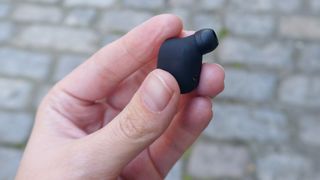
The buds fare better on Bright Eyes’ Road To Joy, where picked guitar ostinatos have a good level of detail, and aren’t overpowered by the meandering bass lines. As the track descends into a cacophony of brass drums and roaring guitars, we’re craving a little more separation in the different frequencies to allow the competing instruments to ‘breathe’.
The soundstage doesn’t have the closed off feeling in ear buds can sometimes have, but it’s also not the widest sounding we’ve heard.
That bassy profile lends itself to bolstering your running performance, but if you’re looking for pure audio fidelity, you’ll want to look elsewhere – the soundstage is just too warm and bottom-heavy to appeal to audiophiles.
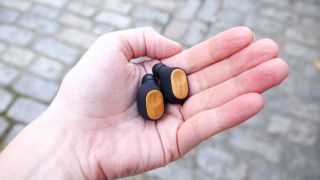
Final verdict
The best thing about the House of Marley Liberate Air true wireless earbuds is their design: they look great, feel really secure, and they’re eco-friendly to boot.
Sound-wise, they’re extremely bassy: this could be ideal for runners who want to bolster their performance, but audiophiles will likely crave a more natural-sounding profile. There are better sounding true wireless earbuds on the market, like the Cambridge Audio Melomania 1s – which incidentally, are also about $20 cheaper.
So, should you buy the Liberate Airs? If you’re serious about saving the planet, they’re a great option for any eco-conscious music fan. Otherwise, you’re better off going for something a little more well-balanced.
Olivia was previously TechRadar's Senior Editor - Home Entertainment, covering everything from headphones to TVs. Based in London, she's a popular music graduate who worked in the music industry before finding her calling in journalism. She's previously been interviewed on BBC Radio 5 Live on the subject of multi-room audio, chaired panel discussions on diversity in music festival lineups, and her bylines include T3, Stereoboard, What to Watch, Top Ten Reviews, Creative Bloq, and Croco Magazine. Olivia now has a career in PR.

How to watch Liège-Bastogne-Liège 2024: live stream men's cycling online from anywhere

A key Apple app is rumored to be getting a major upgrade in macOS 15

Intel's formidable 288 core CPU now has a proper family name — Granite Rapids and Sierra Forest are Xeon 6 processors but is it just becoming too confusing?
